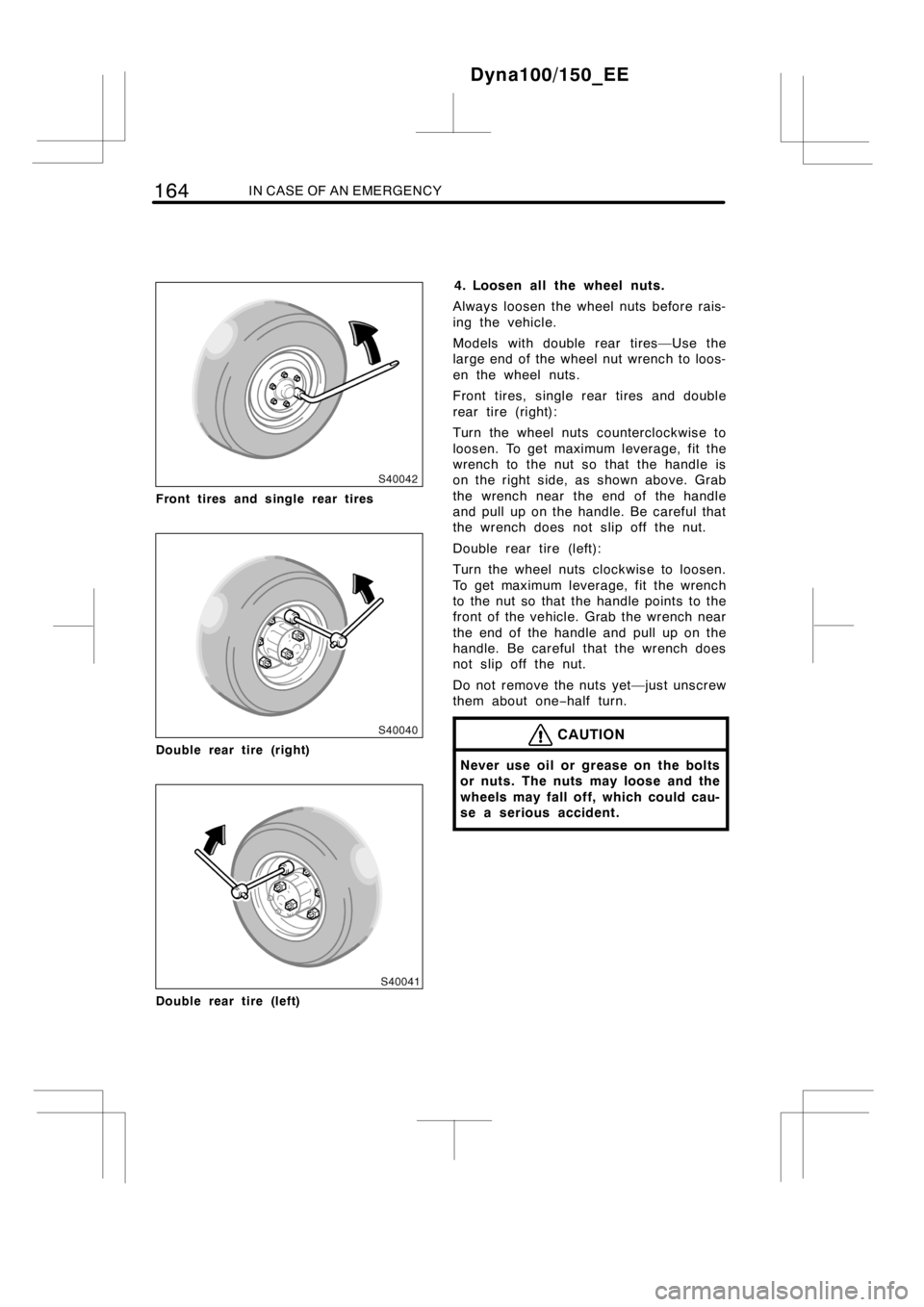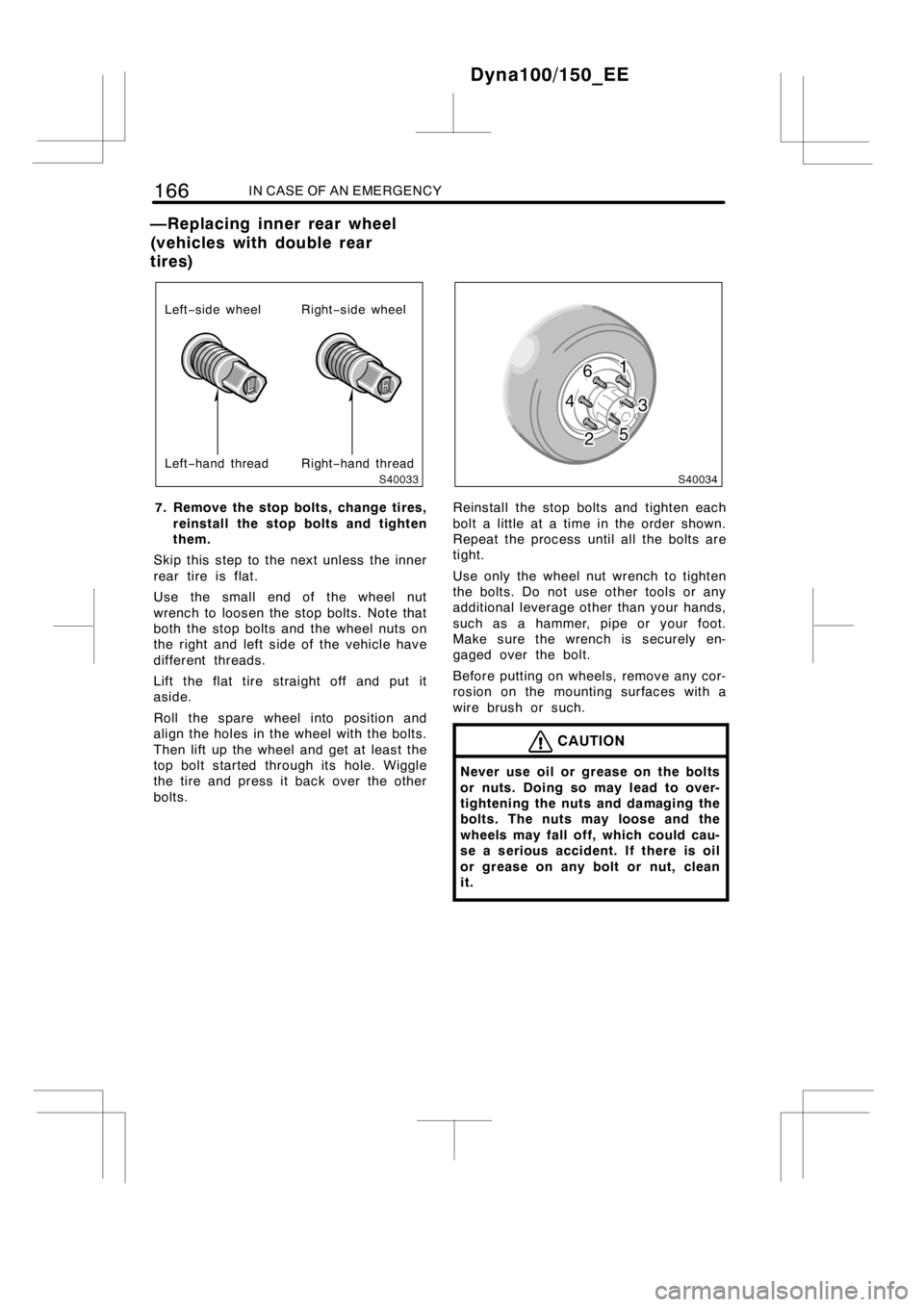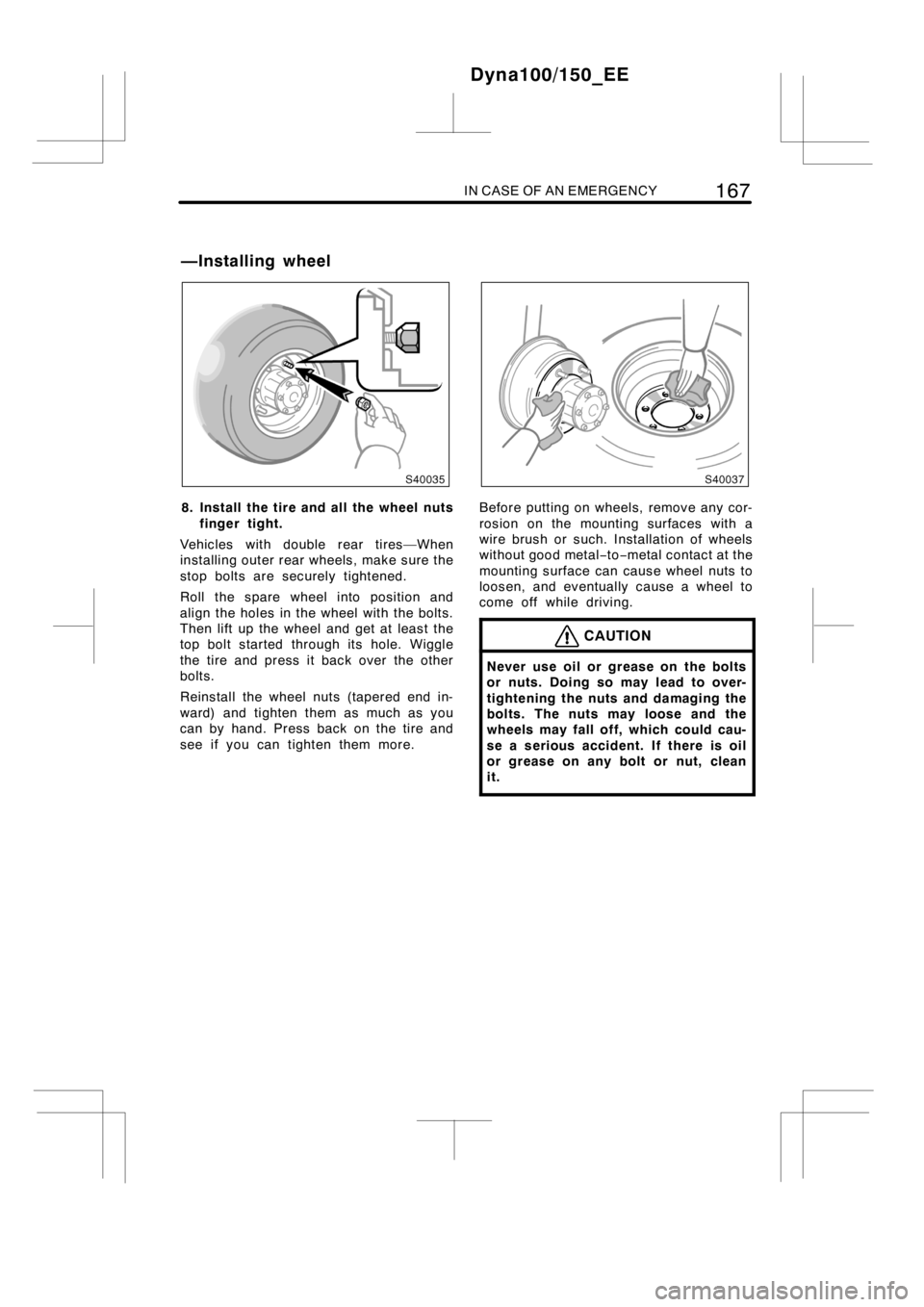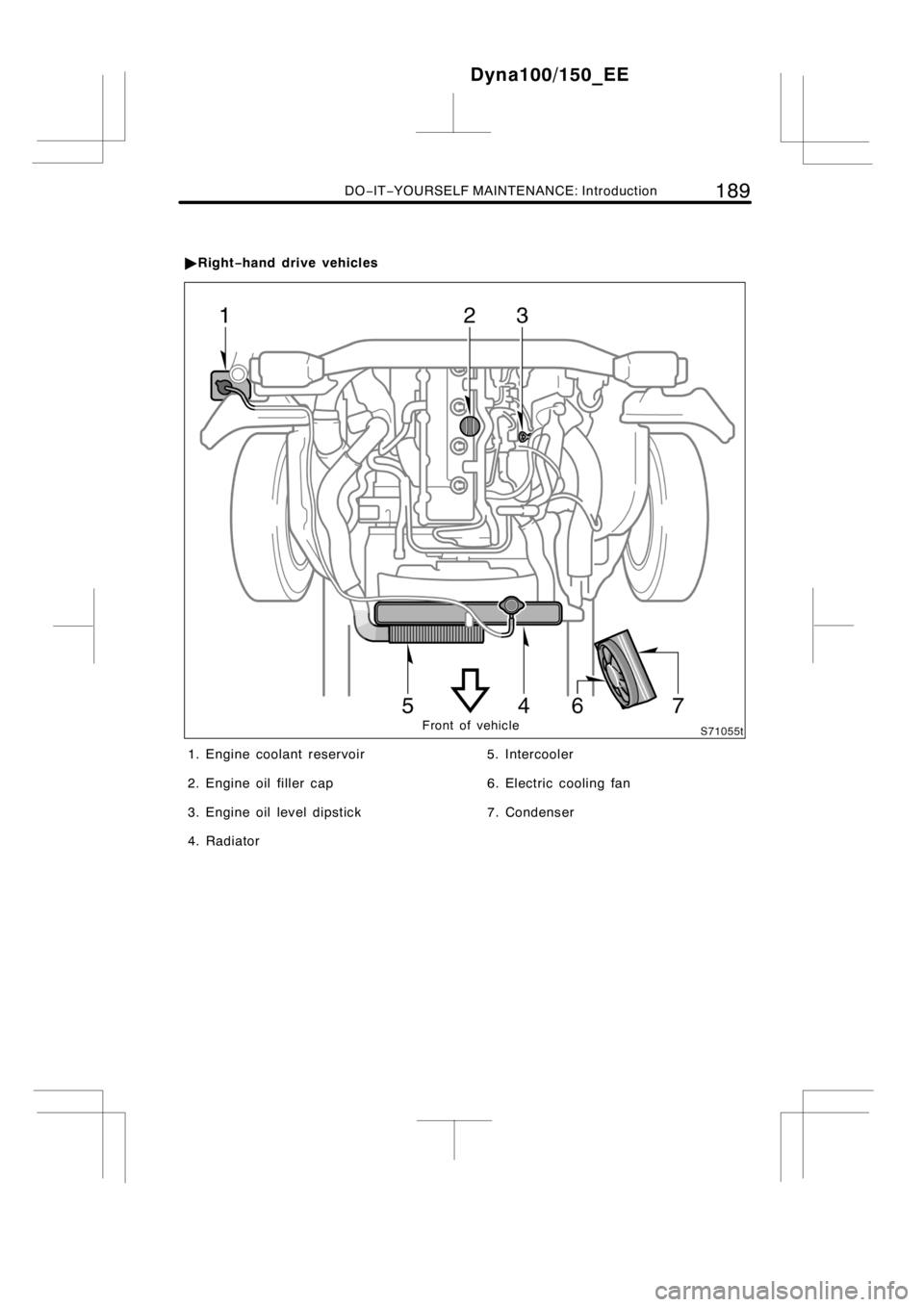2012 TOYOTA DYNA 100/150 oil
[x] Cancel search: oilPage 153 of 240

STARTING AND DRIVING147
DMaintain a moderate speed on high-
ways.The faster you drive, the greater
the fuel consumption. By reducing your
speed, you will cut down on fuel con-
sumption.
DKeep the front wheels in proper
alignment.Avoid hitting the curb and
slow down on rough roads. Improper
alignment not only causes faster tire
wear but also puts an extra load on
the engine, which, in turn, wastes fuel.
DKeep the bottom of your vehicle free
from mud, etc.This not only lessens
weight but also helps prevent corro-
sion.
DKeep your vehicle tuned−up and in
top shape.A dirty air cleaner, carbure-
tor out of adjustment, improper valve
clearance, dirty plugs, dirty oil and
grease, brakes not adjusted, etc. all
lower engine performance and contrib-
ute to poor fuel economy. For longer
life of all parts and lower operating
costs, keep all maintenance work on
schedule, and if you often drive under
severe conditions, see that your vehicle
receives more frequent maintenance.
CAUTION
Never turn off the engine to coast
down hills. Your power steering and
brake booster will not function with-
out the engine running. Also, the
emission control system operates
properly only when the engine is run-
ning.
Dyna100/150_EE
Page 162 of 240

156IN CASE OF AN EMERGENCY
If your engine coolant temperature
gauge indicates overheating, if you ex-
perience a loss of power, or if you hear
a loud knocking or pinging noise, the
engine has probably overheated. You
should follow this procedure...
1. Pull safely off the road, stop the ve-
hicle, and turn on your emergency
flashers. Put the transmission in neu-
tral and apply the parking brake. Turn
off the air conditioning if it is being
used.
2. If coolant or steam is boiling out of the
radiator or reservoir, stop the engine.
Wait until the steam subsides before
opening the engine access hole cover
or tilting the cab. If there is no coolant
or steam boiling over, leave the engine
running and make sure the electric
cooling fan is operating. If it is not,
turn the engine switch off.
CAUTION
To help avoid serious injury, keep the
engine access hole cover closed or
the cab lowered until there is no
steam. Escaping steam or coolant is
a sign of very high pressure.
3. Visually check to see if the engine
drive belt (fan belt) is broken or loose.
Look for obvious coolant leaks from the
radiator, hoses, and under the vehicle.
However, note that water draining from
the air conditioning is normal if it has
been used.
CAUTION
When the engine is running, keep
hands and clothing away from the
moving fan and engine drive belts.
4. If the engine drive belt is broken or the
coolant is leaking, stop the engine im-
mediately. Call any authorized Toyota
dealer or repairer, or another duly qual-
ified and equipped professional, for as-
sistance.
5. If the engine drive belt is O.K. and
there are no obvious leaks, you may
help the engine cool down more quickly
by running it at about 1500 rpm for a
few minutes with the accelerator pedal
lightly depressed.
6. Check the coolant reservoir. If it is dry,
add coolant to the reservoir while the
engine is running. Fill it about half full.
For the coolant type, see “Coolant type
selection” on page 199 in Section 7−2.
CAUTION
Do not attempt to remove the radiator
cap when the engine and radiator are
hot. Serious injury could result from
scalding hot fluid and steam blown
out under pressure.
7. After the engine coolant temperature
has cooled to normal, again check the
coolant level in the reservoir. If neces-
sary, bring it up to half full again.
Serious coolant loss indicates a leak in
the system. You should have it
checked as soon as possible at any
authorized Toyota dealer or repairer, or
another duly qualified and equipped
professional.
Dyna100/150_EE
If your vehicle overheats
Page 170 of 240

164IN CASE OF AN EMERGENCY
Front tires and single rear tires
Double rear tire (right)
Double rear tire (left)
4. Loosen all the wheel nuts.
Always loosen the wheel nuts before rais-
ing the vehicle.
Models with double rear tires—Use the
large end of the wheel nut wrench to loos-
en the wheel nuts.
Front tires, single rear tires and double
rear tire (right):
Turn the wheel nuts counterclockwise to
loosen. To get maximum leverage, fit the
wrench to the nut so that the handle is
on the right side, as shown above. Grab
the wrench near the end of the handle
and pull up on the handle. Be careful that
the wrench does not slip off the nut.
Double rear tire (left):
Turn the wheel nuts clockwise to loosen.
To get maximum leverage, fit the wrench
to the nut so that the handle points to the
front of the vehicle. Grab the wrench near
the end of the handle and pull up on the
handle. Be careful that the wrench does
not slip off the nut.
Do not remove the nuts yet—just unscrew
them about one−half turn.
CAUTION
Never use oil or grease on the bolts
or nuts. The nuts may loose and the
wheels may fall off, which could cau-
se a serious accident.
Dyna100/150_EE
Page 172 of 240

166IN CASE OF AN EMERGENCY
Left−side wheel
Right−hand thread Left−hand threadRight−side wheel
7. Remove the stop bolts, change tires,
reinstall the stop bolts and tighten
them.
Skip this step to the next unless the inner
rear tire is flat.
Use the small end of the wheel nut
wrench to loosen the stop bolts. Note that
both the stop bolts and the wheel nuts on
the right and left side of the vehicle have
different threads.
Lift the flat tire straight off and put it
aside.
Roll the spare wheel into position and
align the holes in the wheel with the bolts.
Then lift up the wheel and get at least the
top bolt started through its hole. Wiggle
the tire and press it back over the other
bolts.Reinstall the stop bolts and tighten each
bolt a little at a time in the order shown.
Repeat the process until all the bolts are
tight.
Use only the wheel nut wrench to tighten
the bolts. Do not use other tools or any
additional leverage other than your hands,
such as a hammer, pipe or your foot.
Make sure the wrench is securely en-
gaged over the bolt.
Before putting on wheels, remove any cor-
rosion on the mounting surfaces with a
wire brush or such.
CAUTION
Never use oil or grease on the bolts
or nuts. Doing so may lead to over-
tightening the nuts and damaging the
bolts. The nuts may loose and the
wheels may fall off, which could cau-
se a serious accident. If there is oil
or grease on any bolt or nut, clean
it.
Dyna100/150_EE
—Replacing inner rear wheel
(vehicles with double rear
tires)
Page 173 of 240

IN CASE OF AN EMERGENCY167
8. Install the tire and all the wheel nuts
finger tight.
Vehicles with double rear tires—When
installingouter rear wheels, make sure the
stop bolts are securely tightened.
Roll the spare wheel into position and
align the holes in the wheel with the bolts.
Then lift up the wheel and get at least the
top bolt started through its hole. Wiggle
the tire and press it back over the other
bolts.
Reinstall the wheel nuts (tapered end in-
ward) and tighten them as much as you
can by hand. Press back on the tire and
see if you can tighten them more.Before putting on wheels, remove any cor-
rosion on the mounting surfaces with a
wire brush or such. Installation of wheels
without good metal−to−metal contact at the
mounting surface can cause wheel nuts to
loosen, and eventually cause a wheel to
come off while driving.
CAUTION
Never use oil or grease on the bolts
or nuts. Doing so may lead to over-
tightening the nuts and damaging the
bolts. The nuts may loose and the
wheels may fall off, which could cau-
se a serious accident. If there is oil
or grease on any bolt or nut, clean
it.
Dyna100/150_EE
—Installing wheel
Page 194 of 240

188DO−IT−YOURSELF MAINTENANCE: Introduction
Front of vehicle
1. Engine coolant reservoir
2. Engine oil filler cap
3. Engine oil level dipstick
4. Radiator5. Intercooler
6. Electric cooling fan
7. Condenser
Dyna100/150_EE
Engine compartment overview
"Left−hand drive vehicles
Page 195 of 240

DO−IT−YOURSELF MAINTENANCE: Introduction189
Front of vehicle
1. Engine coolant reservoir
2. Engine oil filler cap
3. Engine oil level dipstick
4. Radiator5. Intercooler
6. Electric cooling fan
7. Condenser
Dyna100/150_EE
"Right−hand drive vehicles
Page 199 of 240

DO−IT−YOURSELF MAINTENANCE: Introduction193
If you perform maintenance by yourself,
be sure to follow the correct procedure
given in this Section.
You should be aware that improper or in-
complete servicing may result in operating
problems.
This Section gives instructions only for
those items that are relatively easy for an
owner to perform. As explained in Section
6, there are still a number of items that
must be done by a qualified technician
with special tools.
Utmost care should be taken when work-
ing on your vehicle to prevent accidental
injury. Here are a few precautions that
you should be especially careful to ob-
serve:
CAUTION
DWhen the engine is running, keep
hands, clothing, and tools away
from the moving fan and engine
drive belts. (Removing rings,
watches, and ties is advisable.)
DRight after driving, the engine
compartment—the engine, radiator,
exhaust manifold and power steer-
ing fluid reservoir, etc.—will be hot.
So be careful not to touch them.
Oil and fluids may also be hot.
DIf the engine is hot, do not remove
the radiator cap or loosen the drain
plugs to prevent burning yourself.
DDo not leave anything that may
burn easily, such as paper or rags,
in the engine compartment.
DDo not smoke, cause sparks or al-
low open flames around fuel or the
battery. Their fumes are flammable.
DBe extremely cautious when work-
ing on the battery. It contains poi-
sonous and corrosive sulfuric acid.
DDo not get under your vehicle with
just the body jack supporting it. Al-
ways use automotive jack stands or
other solid supports.
DBe sure that the engine switch is
off if you work near the electric
cooling fans. With the engine
switch on, the electric cooling fans
will automatically start to run if the
engine coolant temperature is high
and/or the air conditioning is on.
DUse eye protection whenever you
work on or under your vehicle
where you may be exposed to flying
or falling material, fluid spray, etc.
DUsed engine oil contains potentially
harmful contaminants which may
cause skin disorders such as in-
flammation or skin cancer, so care
should be taken to avoid prolonged
and repeated contact with it. To re-
move used engine oil from your
skin, wash thoroughly with soap
and water.
DDo not leave used oil within the
reach of children.
DDispose of used oil and filter only
in a safe and acceptable manner.
Do not dispose of used oil and fil-
ter in household trash, in sewers or
onto the ground. Call your dealer or
a service station for information
concerning recycling or disposal.
DTake care when filling the brake and
clutch fluid reservoirs because
brake fluid can harm your hands or
eyes. If fluid gets on your hands or
in your eyes, flush the affected area
with clean water immediately. If you
still feel uncomfortable with your
hands or eyes, go to the doctor.
Dyna100/150_EE
Do−it−yourself service
precautions